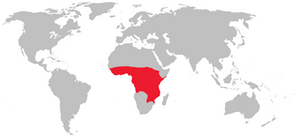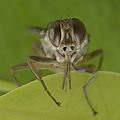Tsetse fly facts for kids
Quick facts for kids Tsetse fly |
|
|---|---|
 |
|
| Tsetse fly | |
| Scientific classification |
|
| Kingdom: | Animalia |
| Phylum: | Arthropoda |
| Class: | Insecta |
| Order: | Diptera |
| Suborder: | Brachycera |
| Infraorder: | Muscomorpha |
| Section: | Schizophora |
| Subsection: | Calyptratae |
| Superfamily: | Hippoboscoidea |
| Family: | Glossinidae Theobald, 1903 |
| Genus: | Glossina Wiedemann, 1830 |
| Species groups | |
|
|
 |
|
| Range of the tsetse fly | |
Tsetse flies are a type of large, biting flies found in warm, tropical parts of Africa. These flies bite vertebrate animals, including humans, to drink their blood. They are known for spreading serious diseases, like sleeping sickness, which is why scientists have studied them a lot.
There are about 34 different kinds of tsetse flies, all belonging to the group called Glossina. These flies live in three main types of places. Some live in open grasslands called the savannah. Others prefer areas near rivers, and a third group lives deep in tropical forests.
Life cycle of the Tsetse Fly
Tsetse flies have a very unusual life cycle compared to most insects. A female tsetse fly only fertilizes one egg at a time. She keeps this egg inside her body, in a special area called the uterus. The young fly, called a larva, starts to grow inside her.
While the larva is developing, the mother fly feeds it. She produces a milky substance from a special gland in her uterus, which the larva drinks. This is how the young fly gets all its food before it is born.
When the larva is big enough, it leaves the mother's body. It then crawls into the ground. There, it forms a hard outer shell around itself and becomes a pupa. Inside this shell, the pupa changes and grows, a process called metamorphosis. After about twenty to thirty days, a full adult tsetse fly emerges from the pupa.
Most insect larvae eat a lot before they turn into a pupa. But tsetse larvae do not eat anything once they leave their mother. They rely completely on the food their mother gave them. This shows how rich blood is as a food source for the mother fly. She needs enough energy for herself, for her growing baby, and to store food for the baby until it becomes an adult.
Controlling Tsetse Flies
For a long time, people and their farm animals simply avoided living in areas where tsetse flies were common. In the 1900s, people started using pesticides to kill the flies. However, this often caused new problems for the environment.
Today, scientists use more careful methods to control tsetse flies. One way is to use special traps. These traps often have large blue cloths that attract the flies. Another clever method is to release male tsetse flies that have been treated with radiation. This makes them sterile, meaning they cannot have babies. Since female tsetse flies usually mate only once in their lives, if they mate with a sterile male, they won't produce any offspring. This helps to greatly reduce the number of flies over time.
Images for kids
-
A giraffe in Serengeti National Park, Tanzania
-
Trypanosomes (tiny parasites) in a blood sample
See also
 In Spanish: Mosca tsé-tsé para niños
In Spanish: Mosca tsé-tsé para niños







